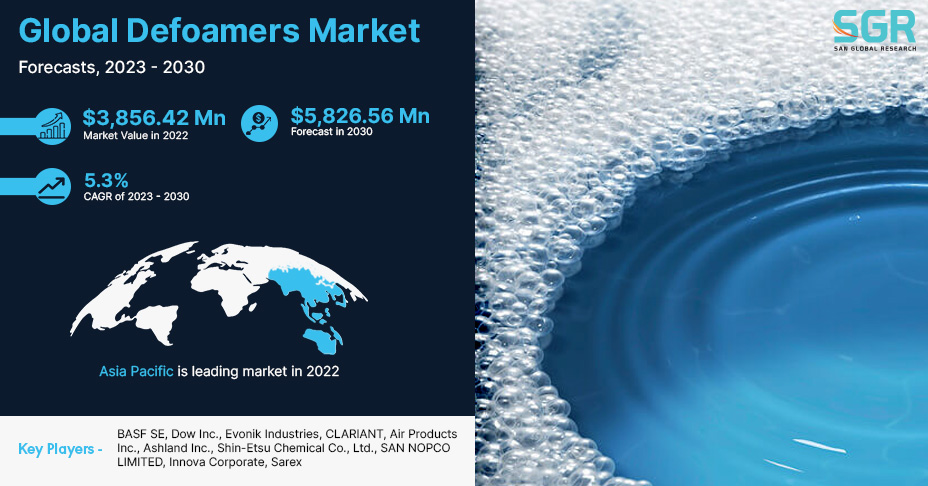Selecting the Right Defoamer for Your Details Application Needs
Picking the appropriate defoamer for details application demands is a nuanced procedure that requires mindful factor to consider of several variables, such as the foam operating, tool, and type conditions. Comprehending the subtleties of defoamer efficiency-- including speed and perseverance-- while also making up ecological and regulative factors is important. Additionally, engaging in trials and seeking advice from producers can provide beneficial insights. Navigating these intricacies can be daunting, and the consequences of an inadequate option might be substantial. What strategies can be employed to make certain an optimal option?
Comprehending Foam Development
Foam formation occurs when gas is entraped within a fluid, developing a steady structure of bubbles. This sensation can considerably influence numerous industrial procedures, especially in fields such as food production, drugs, and wastewater therapy. The presence of foam can impede mixing, decrease product high quality, and even lead to operational inadequacies.
Foam generally creates as a result of a combination of elements, consisting of surface-active agents, frustration, and the characteristics of the liquid phase. Surfactants lower the surface area tension of the fluid, promoting the formation of bubbles that can integrate and stabilize. Frustration, whether from mechanical stirring or gas intro, boosts bubble formation, leading to raised foam quantity.
Recognizing the mechanics of foam formation is important for markets aiming to maximize their procedures. By identifying the certain problems that promote foam generation, organizations can carry out approaches to alleviate its impacts.
Sorts Of Defoamers Available
Various sorts of defoamers are available to deal with the challenges postured by foam in industrial applications. defoamers. Generally classified, defoamers drop right into 3 classifications: silicone-based, non-silicone-based, and natural defoamers
Silicone-based defoamers are renowned for their effectiveness and security across a vast variety of temperature levels and pH levels. They are typically used in applications where strong foam reductions is needed, such as in paints, adhesives, and coverings. Their reduced surface tension enables fast foam collapse.
Non-silicone-based defoamers, commonly made from organic compounds, supply an option for applications sensitive to silicone residues. These defoamers can be additional divided right into polyether and ester types, each tailored to meet details formulation requirements. Non-silicone defoamers are often made use of in food handling and individual treatment products as a result of their compatibility with numerous formulations.
Natural defoamers, obtained from plant or animal resources, are gaining traction because of their environment-friendly profile. These products are especially appealing in applications where regulative compliance and sustainability are extremely important, such as in agrochemicals and biotechnology.
Choosing the right kind of defoamer is crucial for enhancing performance and making certain compatibility with specific applications.
Trick Application Considerations
When selecting a defoamer, it is important to take into consideration the details application requirements to make sure optimal performance. defoamers. Different markets have distinct requirements, such as food handling, drugs, or wastewater therapy, and each application may require one-of-a-kind defoaming properties
Key factors to evaluate include the tool in which the defoamer will be utilized, whether it is water-based, oil-based, or a combination thereof. The temperature and pH degrees of the application can likewise substantially affect the efficiency of a defoamer. Furthermore, compatibility with other chemicals present in the system is critical to avoid damaging reactions that can jeopardize performance.
An additional important view website factor to consider is the lathering actions of the details system. Understanding whether the foam develops swiftly or gradually can guide the option of a defoamer that targets the root cause effectively. Moreover, the desired rate of defoaming can influence the selection, as some applications call for quick action while others may tolerate slower defoaming processes.
Finally, environmental and regulative factors to consider ought to not be forgotten, especially in markets with rigorous compliance needs. Picking a defoamer that aligns with these aspects guarantees both effectiveness and safety and security in the application.

Performance Testing Methods
Examining the performance of a defoamer calls for a methodical approach to testing that accurately measures its performance in specific applications. Different efficiency screening techniques can be employed to identify the optimum defoamer for a provided formula.
One typical approach is the bubble test, which evaluates the defoamer's capacity to decrease foam volume over time. This test includes producing a stable foam and then adding the defoamer to observe the price of foam collapse.

Inevitably, picking the ideal performance screening approach depends upon the details application and the sort of foam being dealt with. Each method uses beneficial information that can lead formulation adjustments and boost the effectiveness of the defoamer in sensible applications.
Best Practices for Choice


Following, consider the defoamer's efficiency in regards to speed of activity and persistence. A quick-acting defoamer might be essential for processes where fast foam reductions is vital, while a much more consistent formula could be view required for long term foam control. In addition, evaluate the environmental effect of the defoamer, including its biodegradability and any regulatory conformity requirements.
Conduct trials with picked defoamers to determine their performance in real-world conditions. By adhering to these ideal practices, you can enhance foam control efficiency and guarantee the long life of your processes.
Conclusion
In summary, choosing the proper defoamer necessitates a thorough analysis of numerous aspects, including foam type, medium, operating conditions, and ecological considerations. Recognizing the distinct qualities of foam formation and the readily available defoamer options is important.
Choosing the appropriate defoamer for details application needs is a nuanced process that requires careful factor to consider of numerous factors, such as the foam kind, operating, and tool conditions.Selecting the ideal defoamer is essential for attaining optimum performance in foam control applications. A quick-acting defoamer might be required for procedures where quick foam reductions is vital, while a more relentless formulation might be needed for long term foam control.In recap, picking the ideal defoamer requires a detailed analysis of various elements, including foam kind, tool, operating problems, and environmental factors to consider. Understanding the one-of-a-kind attributes of he said foam formation and the readily available defoamer options is important.